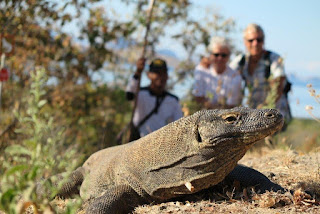 |
| Departing Komodo Island, Indonesia on the morning of July 5th. |
We departed Indonesia from the Komodo Village area on July
5th and headed back to Australia. It took a couple days waiting in Indonesia to receive official confirmation from the Australia Border officials regarding our notification of intent to
arrive in the port of Dampier on or about the 10th of July. Once we got confirmation, we departed.
The 750 mile trip to the northwest coast of Australia would
take 5 or 6 days of around the clock sailing, plus or minus.
We had been looking at the weather forecasts for the Timor
Sea for several days, as it is important to pick a ‘weather window’ that avoids
the ‘re-enforced trade winds’ if at all possible. When a strong High Pressure system develops
over Australia, it acts to compress the pressure gradient over the Timor Sea,
and the normally 10-20 knot easterly trade winds can easily become twice as
strong. We found a reasonably good
window for the second week of July, but knew the winds would be picking up as
we approached the Australia coast.
Our first two days out were magical trade wind sailing. Warm weather, clear skies and a nice 10-20
easterly wind made for a nice sail. We
skirted to the west of the large island of Sumba, (Indonesia) and saw several
large squid fishing boats more than 40 miles offshore during the dark, moonless
night. Encountering local squid
(fishing) boats at sea at night is difficult as they carry only large white
lights, no navigational lights to indicate which direction they are headed. As it was, we never came close enough to one
to worry.
Day 3 was nearly windless, with the wind dying at 6 am abruptly
and not going over 2 knots until about 8 pm. Like magic, we motored through a
small cloud bank and once again, the easterly trade winds started to blow.
The first 3 or 4 nights out were just jam packed with flying
fish…The 3rd morning out, there were more than 20 on the deck after
a night of jumping in our bow wake.
The 4th day, the wind slowly swung to the south,
so we took the opportunity to sail to the southeast, as we knew the next day,
stronger winds directly from the east were due.
Making easting now, in lighter winds would allow us to sail with a more favorable
(comfortable) wind angle once the winds built.
Thursday night, we were once again headed straight south
towards Australia and the wind slowly built.
By morning, it was howling pretty steady in the upper 20’s, gusting in
to the upper 30’s (knots). We were
sailing under a double reefed main and staysail, hard on the wind (close
hauled), going straight south towards the coast of Australia. The seas were huge, breaking and coming at us
every seven seconds or so.
At sunrise, we lowered the main entirely and turned down
wind another 20 degrees, aiming right for our destination (Dampier) and sailed
the rest of the way with just our smallest sail, a staysail alone. I must
say, it was a bit of a frightening experience for us both when Eric needed to
go forward to the mast, climb up several feet to drop the main. Once finished,
he needed to time his decent to wait for waves to wash over the boat, before
dashing back in to the cockpit. We spend
most the next night and day with the washboards in tight, to keep water from
the odd wave from splashing in below decks.
We needed to average 6 knots for the next 24 hours to get in
to Dampier during the daylight hours. We
had no trouble making that rate, in fact it was a bit of a challenge to slow ourselves
down in the high winds, despite hardly having any sail up. It was a long night of high winds, we had
about 10 minutes of 45 knots plus, and most of the night between 35 and 42
knots. We took shortened shifts, to
allow each other more rest as keeping watch was pretty fatiguing. Even sleeping was a challenge, given the
motion of the boat.
Katmai did fine, but we were sure glad to round the Burrup Cape
at day break make our way down the Mermaid Bay, towards Dampier. Twenty-five miles down the bay, it was still
gusting more than 30 knots in the harbor when we picked up a mooring in front
of the Hampton Harbor Sailing Club.
It has been a windy week here along the northwest coast, and
we are staying put until it moderates.
Next Stop, likely Exmouth, about 200 miles to the southwest. Until then, we will surely enjoy all that
Dampier has to offer!



















































